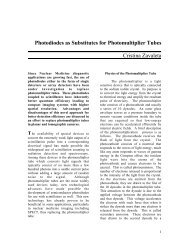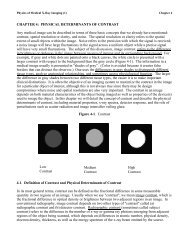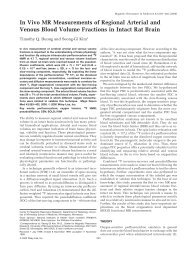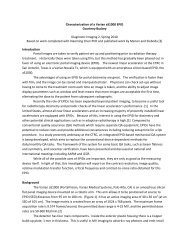MRI Artifacts: Mechanism and Control
MRI Artifacts: Mechanism and Control
MRI Artifacts: Mechanism and Control
Create successful ePaper yourself
Turn your PDF publications into a flip-book with our unique Google optimized e-Paper software.
The slice-overlap artifact is the loss of signal seen in an image from a multi-angle,<br />
multi-slice acquisition, as is obtained commonly in the lumbar spine. If the slices<br />
obtained at different disk spaces are not parallel, then the slices may overlap. If two<br />
levels are done at the same time, e.g., L4-5 <strong>and</strong> L5-S1, then the level acquired second<br />
will include spins that have already been saturated. This causes a b<strong>and</strong> of signal loss<br />
crossing horizontally in image, usually worst posteriorly. Therefore, overlap of<br />
sections within areas of diagnostic interest should be carefully avoided.<br />
I. RF Overflow <strong>Artifacts</strong><br />
RF overflow artifacts cause a non-uniform, washed-out appearance to an image. This<br />
artifact occurs when the signal received by the scanner from the patient is too intense<br />
to be accurately digitized by the analog-to-digital converter. Autoprescanning usually<br />
adjusts the receiver gain to prevent this from occurring but if the artifact still occurs,<br />
the receiver gain can be decreased manually.<br />
J. Entry Slice Phenomenon<br />
Entry slice phenomenon occurs when unsaturated spins in blood first enter into a<br />
slice or slices. It is characterized by bright signal in a blood vessel (artery or vein) at<br />
the first slice that the vessel enters. Usually the signal is seen on more than one slice,<br />
fading with distance. This artifact has been confused with thrombosis with disastrous<br />
results. The characteristic location <strong>and</strong> if necessary, the use of gradient echo flow<br />
techniques can be used to differentiate entry slice artifacts from occlusions.<br />
K. Zipper <strong>Artifacts</strong><br />
There are various causes for zipper artifacts in images. Most of them are related to<br />
hardware or software problems beyond the physicist immediate control. The zipper<br />
artifacts that can be controlled easily are those due to RF entering the scanning room<br />
when the door is open during acquisition of images. 7 RF from some radio transmitters<br />
will cause zipper artifacts that are oriented perpendicular to the frequency axis of<br />
image. Broad-b<strong>and</strong> noise degrades the entire image, whereas narrow frequency noise<br />
produces linear b<strong>and</strong>s that transverse the phase-encoding direction of the image.<br />
Solutions include identifying <strong>and</strong> removing external RF sources, ensuring that the<br />
door to the imaging room remains closed, <strong>and</strong> verifying the integrity of the magnet<br />
room enclosure <strong>and</strong> associated seals.<br />
L. Cross-Excitation<br />
Cross-excitation is caused by the imperfect shape of RF slice profiles, which leads to<br />
the unintended excitation of adjacent tissue. This excitation results in the saturation of<br />
such tissue, manifest as decreased signal intensity <strong>and</strong> decreased contrast that can<br />
hinder lesion detection. One way to avoid this artifact is to introduce an intersection<br />
gap that is 10% to 50% of the prescribed section thickness. Another method is<br />
interleaved image acquisition, in which odd-numbered sections are initially acquired,<br />
followed by acquisition of even-numbered sections. 8 Also, optimized RF pulses that<br />
have a more rectangular slice profile can be implemented.<br />
7







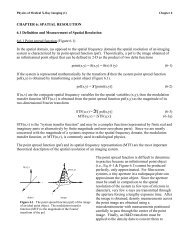
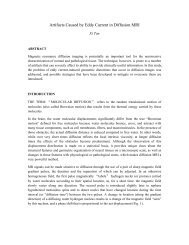
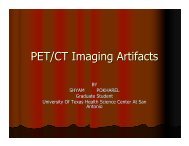
![Methods for preventing Motion Artifacts in MRI [pdf]](https://img.yumpu.com/28806288/1/190x146/methods-for-preventing-motion-artifacts-in-mri-pdf.jpg?quality=85)
